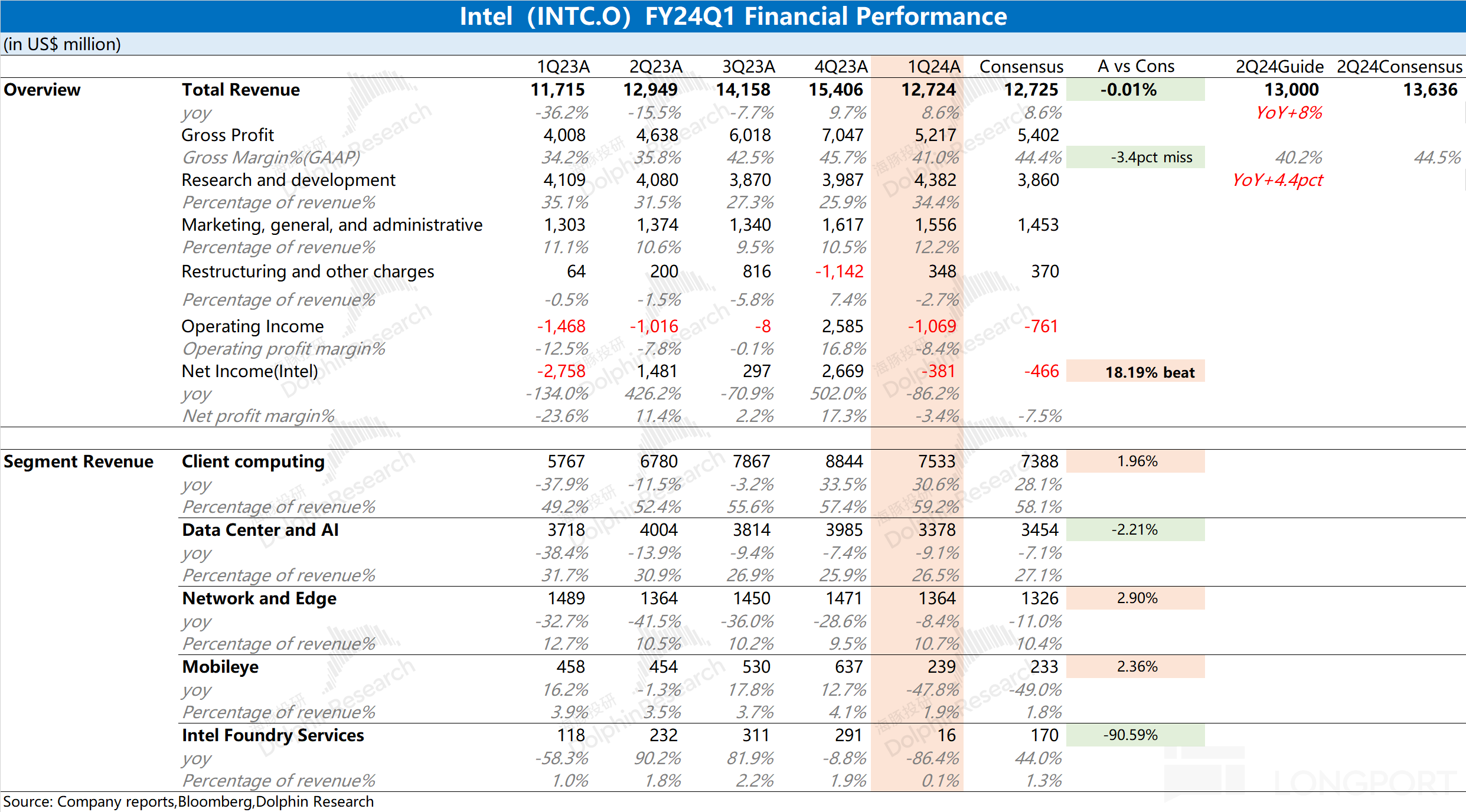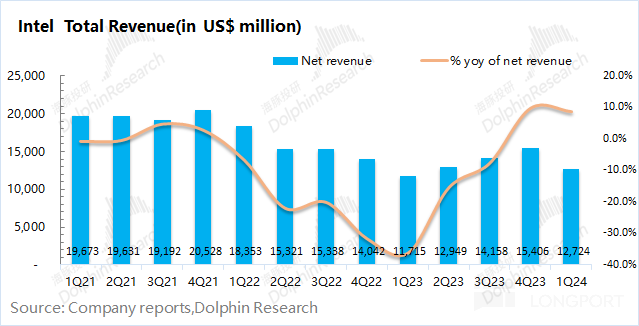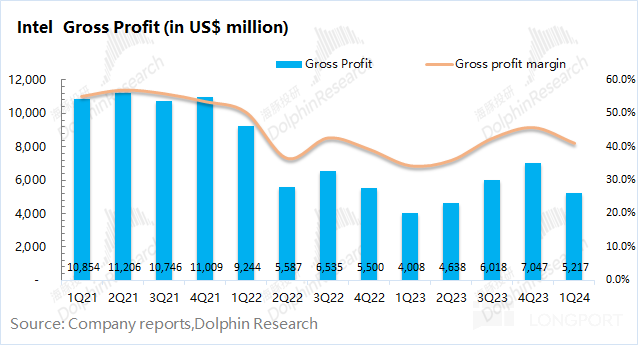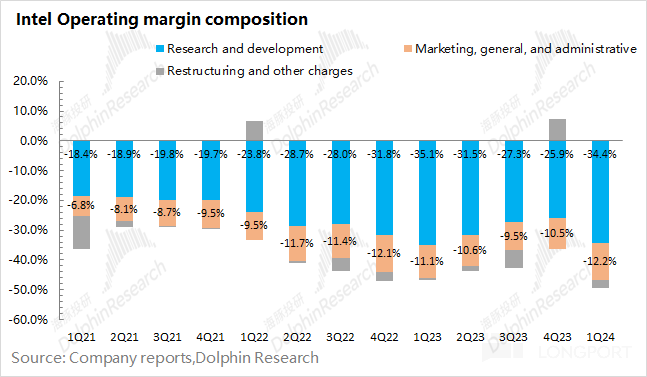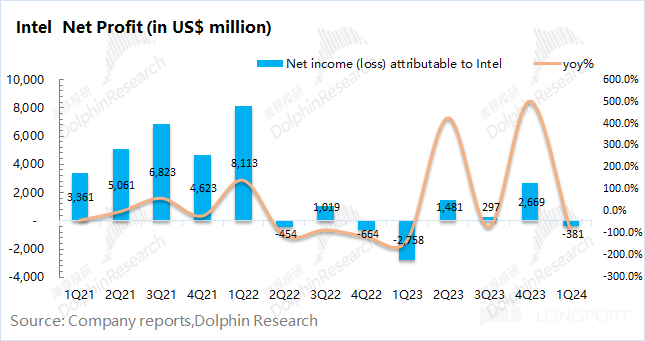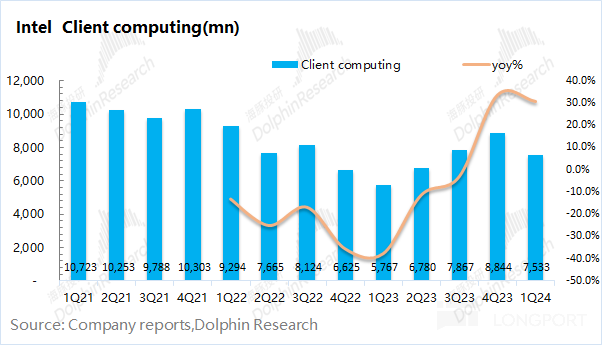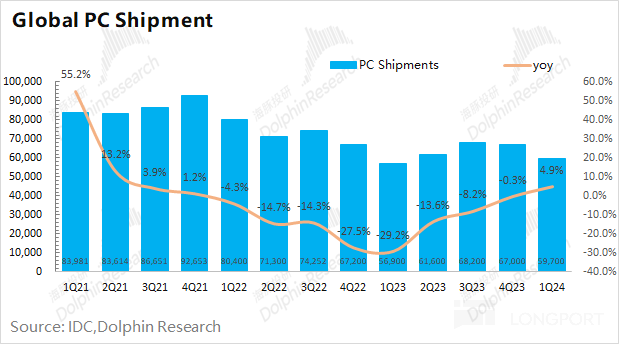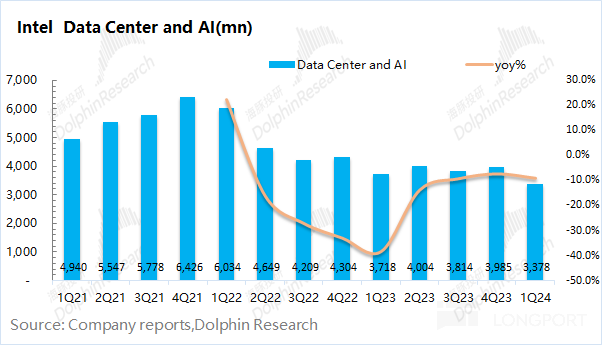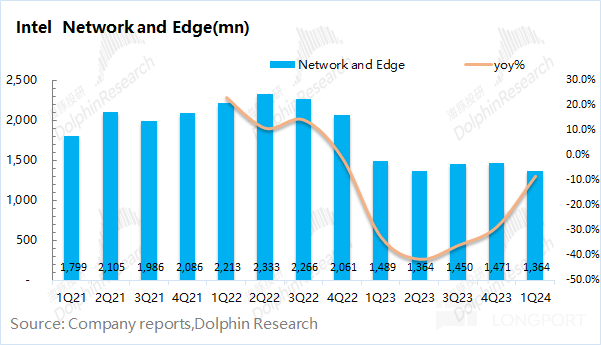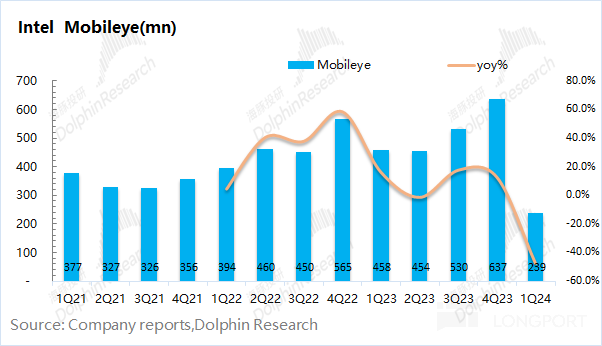
 Likes Received
Likes Received Posts
PostsIntel: The Marginalized AI Onlooker

Intel released its first-quarter financial report for 2024 on the morning of April 26, 2024, after the U.S. stock market closed. The key points are as follows:
1. Core Data: Falling into loss again. Intel achieved revenue of $12.724 billion in the first quarter of 2024, an 8.6% year-on-year increase, meeting market expectations ($12.725 billion). The quarter-on-quarter revenue growth was mainly due to the recovery of the PC client business. Intel's net loss in the first quarter of 2024 was -$381 million, falling into loss again, slightly better than market expectations (-$466 million). The company's loss this quarter was mainly due to the decline in revenue and gross profit margin.
2. Business Situation: PC Decline, AI Struggles. The client business and data center & AI business are the company's largest sources of revenue, accounting for over 80% in total.
1) Client Business: Insufficient PC terminal demand led to a decline in client revenue again. Intel's client revenue in this quarter was $7.533 billion, a 30.6% year-on-year increase.
2) Data Center & AI: Despite high market demand, the company has yet to benefit, with revenue remaining at the $3-4 billion level. This is mainly because the company's GPU products are struggling to break through, while the potential market for CPUs is still being compressed.
3. Intel's Performance Guidance: Expected revenue of $12.5-13.5 billion for the second quarter of 2024 (market expectation $13.6 billion) and a gross margin of 40.2% (market expectation 44.5%). Both revenue and gross margin guidance are not ideal, and the company's performance is expected to continue to be weak.

Dolphin's Viewpoint:
Overall, Intel's financial report this time is not very ideal. Although the company's data is not so bad, it fails to instill confidence in the market. The data center & AI business has yet to show improvement, falling further behind competitors. The PC client business has declined again, still affected by insufficient market demand. The profit side has once again delivered a loss, with no clear signs of operational improvement. In combination with the guidance provided by the company, the company expects revenue of USD 12.5-13.5 billion in the next quarter (market expectation is USD 13.6 billion) and a gross profit margin of 40.2% (market expectation is 44.5%). Both figures are lower than expected, indicating that the company itself is not very optimistic about the operating conditions in the next quarter.
Taking into account the situation of competitors and cloud service providers, the data center and AI markets still show good demand performance, but the company's related business performance seems out of sync with the market. This is mainly because the company is still rooted in the CPU field, while the importance of CPUs in the market is gradually diminishing. The company is struggling to enter the GPU market with satisfactory products, and the gap with competitors is widening.
NVIDIA's stock price is still at a high level, while the company's stock price has recently fallen by 30%, which does not necessarily mean the company is more cost-effective. The company is once again facing losses and no significant improvement in sight, making it difficult to instill confidence in the market, and the company's stock price will continue to be under pressure.
Here is a specific analysis of Intel by Dolphin:
I. Core Data: Falling into Losses Again
1.1 Revenue: Intel achieved revenue of USD 12.724 billion in the first quarter of 2024, an 8.6% year-on-year increase, meeting market expectations (USD 12.725 billion). The quarterly revenue growth is mainly due to the recovery of the PC client business. On a quarter-on-quarter basis, there is usually a seasonal decline in the first quarter.

1.2 Gross Profit and Gross Margin: Intel achieved a gross profit of USD 5.217 billion in the first quarter of 2024, a 30.2% year-on-year increase. In terms of specific gross margin, the company's gross margin for this quarter is 41%, showing a slight decline on a quarter-on-quarter basis, still exhibiting seasonal characteristics. The company has not been significantly driven by the data center and AI businesses, and profits still mainly come from the PC client business.

1.3 Operating Expenses: Intel's operating expenses in the first quarter of 2024 were USD 6.286 billion, a 14.8% year-on-year increase. The increase in operating expenses is mainly due to the rise in research and development expenses and sales expenses.
Looking at the core aspects:
1) Research and Development Expenses: Research and development expenses for this quarter were USD 4.382 billion, a 6.6% year-on-year increase. The research and development expense ratio is 34.4%, with research and development investment still being the largest item in the company's operating expenses;
2) Sales, General, and Administrative Expenses: Sales and management expenses for this quarter were USD 1.556 billion, a 19.4% year-on-year increase; the sales management expense ratio is 12.2%, showing an increase 1.4 Net Profit Situation: In the first quarter of 2024, Intel's net profit was -$381 million, once again incurring a loss for the quarter, slightly better than market expectations (-$466 million). This quarter, the company's profit suffered another loss, mainly due to the decline in revenue and gross profit margin. Although the demand for data centers and AI markets is good, the company did not benefit from it, mainly due to insufficient product strength. Currently, the company's performance still mainly comes from the PC client end, and although this market is showing some improvement, the demand side is still relatively weak, keeping the company's overall performance at a relatively low level.

2. Sub-segment Data Situation: PC Decline, AI Struggles to Take Off
Intel's business consists of client business, data center and AI, network and edge domains, Mobileye, and wafer foundry services. Among them, client business and data center and AI business are the company's largest sources of revenue, accounting for over 80% of the total.
This quarter, the company adjusted its financial statements again, separating out the revenue from Altera in the data center and AI segment, and rewriting Intel's external foundry revenue as wafer foundry revenue and internal business offset items. For the sake of data continuity, we will continue to analyze based on the original business structure.

2.1 Client Revenue
Intel's client revenue reached $7.533 billion in the first quarter of 2024, a year-on-year growth of 30.6%, which is relatively better performing among all business segments . In the business, both Desktop and Notebook showed good year-on-year growth, but there was also a decline compared to the previous quarter, mainly influenced by the overall PC market.

Looking at industry data, after experiencing a bottoming out in quarterly shipments, global PC shipments have rebounded, but this quarter they have once again fallen below 60 million units. This quarter, global PC shipments were 59.7 million units, a year-on-year growth of 4.9%. PC shipments have once again significantly declined, mainly due to the lack of sustained market demand. This has also had a significant impact on the company's performance this quarter .

2.2 Data Center and AI
Intel's data center and AI revenue reached $3.378 billion in the first quarter of 2024, a year-on-year decrease of 9.1%.
In this quarter, after splitting the data center and AI business from the Altera business, the pure data center and AI business amounted to around $30 billion, a slight year-on-year increase of 4.6%.
To observe data continuity, Dolphin still looks at the original business division. The company's overall data center and AI business remained stable, without significant benefits from the industry's demand growth. This is mainly because market growth demand is concentrated on the GPU side, rather than CPU demand. In addition, with the entry of competitors, the company may face greater pressure.

2.3 Networking and Edge Domain
Intel's networking and edge domain revenue reached $1.364 billion in the first quarter of 2024, a year-on-year decrease of 8.4%.
The networking and edge domain business remains sluggish, with the company affected by sustained weak demand and increased customer inventory.

2.4 Other Major Businesses
1) Intel's Mobileye revenue reached $0.239 billion in the first quarter of 2024, a year-on-year decrease of 47.8%. Mobileye Q's inventory is being digested, while also being affected by industry factors.
2) Intel's wafer foundry service revenue reached $0.016 billion in the first quarter of 2024. The company disclosed its wafer foundry business again this quarter, disclosing the company's wafer business and internal offset items. Dolphin combines the two to estimate the company's external foundry service situation. Although the company has been telling the story of wafer foundry in recent years, there is still no significant growth performance at present.

Dolphin Research on Intel and Data Center Companies Article Retrospective:
In January 2024, NVIDIA's conference call "Intel 3, Is it an Opportunity? (Intel 23Q4 Conference Call)" 2024 January NVIDIA Financial Report Review "Intel: No Longer the King of Processors, AI Battle Fails to Materialize"
January 17, 2024 Intel In-depth "Intel: AI PC, Is It the Lifesaver for the 'Toothpaste Factory'?"
November 22, 2023 NVIDIA Conference Call "The First Wave of Artificial Intelligence (NVIDIA 3QFY24 Conference Call)"
November 22, 2023 NVIDIA Financial Report Review "NVIDIA: Computing Power Tsar at Full Throttle? 'Virtual Fire' Flickering"
November 1, 2023 AMD Financial Report Review "Lacking NVIDIA's Explosiveness, AMD's Recovery is Too 'Snail-paced'"
November 1, 2023 AMD Conference Call "AI PC, a New Wave of Productivity (AMD 3Q23 Conference Call)"
Risk disclosure and statement of this article: Dolphin Investment Research Disclaimer and General Disclosure
The copyright of this article belongs to the original author/organization.
The views expressed herein are solely those of the author and do not reflect the stance of the platform. The content is intended for investment reference purposes only and shall not be considered as investment advice. Please contact us if you have any questions or suggestions regarding the content services provided by the platform.

